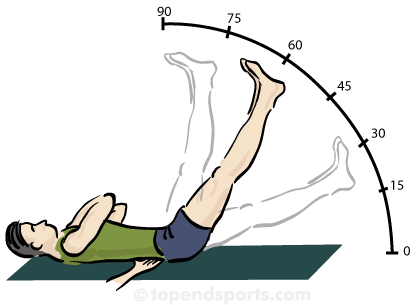The Straight Leg Lift test is a test of abdominal strength, in which the participants slowly lower the straightened legs. This test is important to conduct as poor abdominal muscle strength can cause poor posture leading to lower back pain.
test purpose: The purpose of this test is to estimate the degree of abdominal strength.
equipment required: flat surface, an abdominal strength test board with different degrees of angle marked (otherwise, you can use a protractor, flexometer or goniometer to measure the leg angle)
pre-test: Explain the test procedures to the subject. Perform screening of health risks and obtain informed consent. Prepare forms and record basic information such as age, height, body weight, gender, test conditions. Ensure that the participants are adequately warmed-up. See more details of pre-test procedures.
 procedure: The subject lays supine on the floor next to the abdominal strength test board. The hip joint should be aligned to the intersection of the scale. The arms are held across the chest
and the head rested on the floor. The tester places their finger tips underneath the participant's lower
back. Both legs are raised to a 90-degree angle (vertically)
while keeping the upper body flat on the floor. The subject may bend their knees first to move to the starting position, before straightening the knee joint. The subject aims to sustain the pressure on the tester's fingers under the lower back by
contracting the abdominals as the legs are lowered. The subject slowly lowers both legs until the pressure
on the hand behind the back disappears. The lowest angle observed as the pressure is taken off is the
measurement of their abdominal strength.
procedure: The subject lays supine on the floor next to the abdominal strength test board. The hip joint should be aligned to the intersection of the scale. The arms are held across the chest
and the head rested on the floor. The tester places their finger tips underneath the participant's lower
back. Both legs are raised to a 90-degree angle (vertically)
while keeping the upper body flat on the floor. The subject may bend their knees first to move to the starting position, before straightening the knee joint. The subject aims to sustain the pressure on the tester's fingers under the lower back by
contracting the abdominals as the legs are lowered. The subject slowly lowers both legs until the pressure
on the hand behind the back disappears. The lowest angle observed as the pressure is taken off is the
measurement of their abdominal strength.
scoring: The score is the angle of the legs in degrees from the floor. Below is a guide to scoring for this test
| Angle | Rating |
|---|---|
| 90 | very poor, starting position |
| 75 | poor |
| 60 | below average |
| 45 | average |
| 30 | above average |
| 15 | good |
| 0 | excellent, legs horizontal |
advantages: simple test with minimal equipment needed
comments: The muscles that play a major role in the effort to maintain the position of the low back and pelvis during the leg-lowering movement are the rectus abdominis and external oblique muscles.
Similar Tests
Related Pages
- About Abdominal Testing
- Videos of Sit Up Fitness Tests
- Abdominal endurance test
- Sit up exercise at the beach or at home
- Sit Up World Records


 Current Events
Current Events